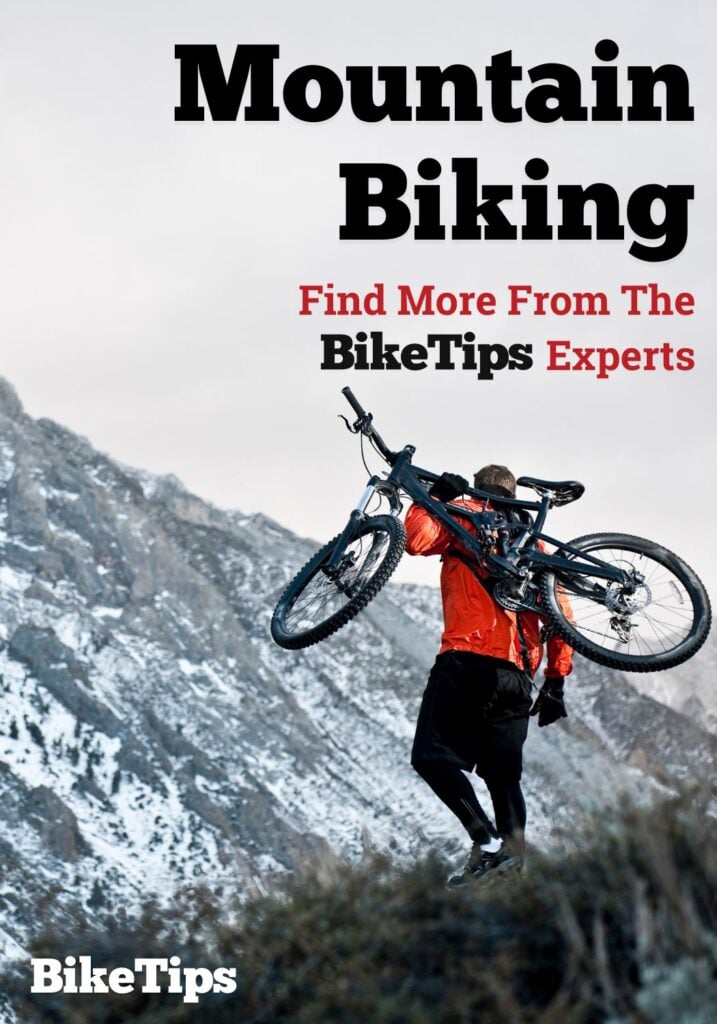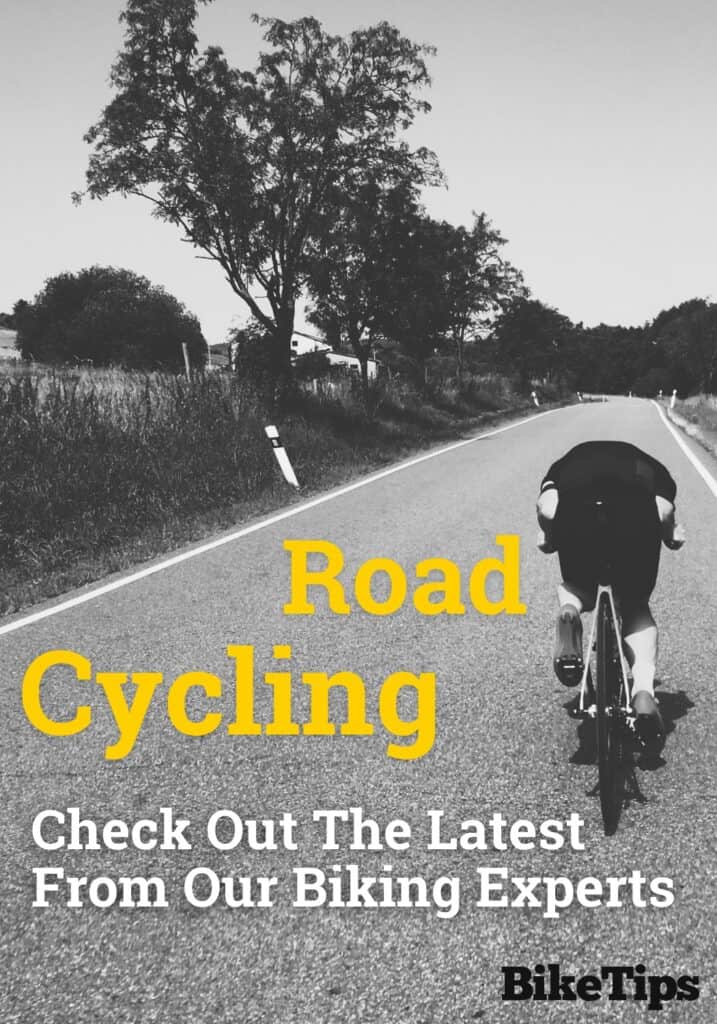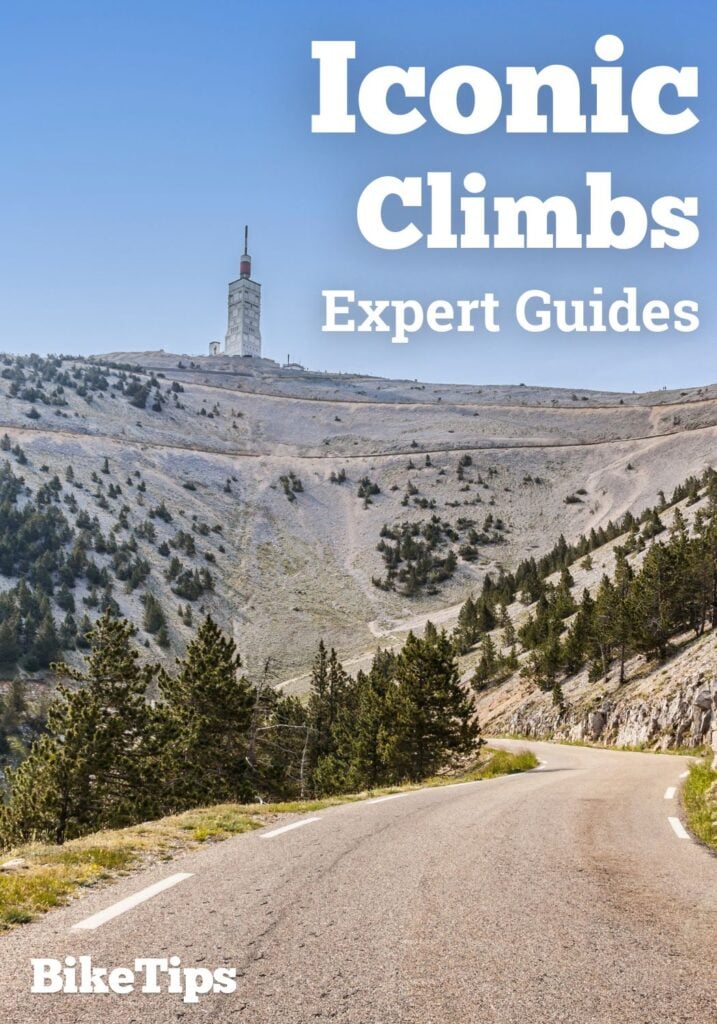Riding a tandem bike can be lots of fun.
It can allow two people with varying fitness levels to ride together. It is also a great way to cover ground quickly, as you combine your strength to power on.
However, you need to be able to communicate well with your partner. Tandem bikes are known as “divorce bikes” for good reason!
But they can also reinforce your relationship or friendship, as they can be a true test of trust and communication.
To get yourselves off to a good start, you need to get the right tandem bike for your needs. There are a few types to choose from and several things to consider before buying.
In this article, we’ll be covering:
- What’s It Like To Ride A Tandem Bike?
- The 6 Different Types Of Tandem Bikes
- 7 Things To Consider Before Buying A Tandem Bike
Ready to learn all about bikes built for two?
Let’s get started!
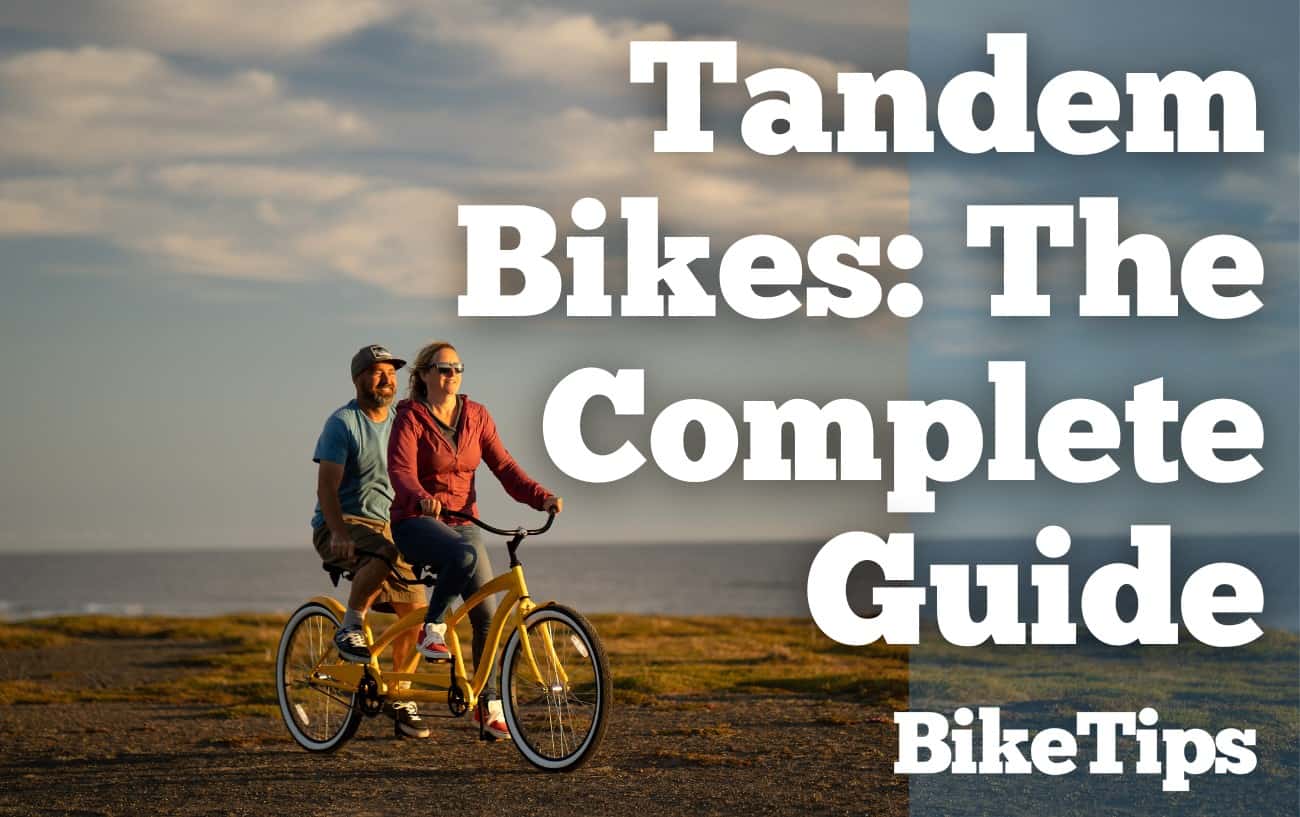
What’s It Like To Ride A Tandem Bike?
A tandem bike is a great way to spend quality time together. But, you’ll need to work as a team to eventually become perfectly synchronized.
Getting to this point takes time, effort, compromises, and lots of patience. But once you manage to become an effective team, you’ll enjoy the high speeds and unique feeling of riding a bike made for two.
The person at the front of a tandem is called the captain, and the one at the back is called the stoker. The captain operates the brakes and gears, while the stoker only has to pedal.
However, you will soon catch them up on the downhills and flats. The extra weight of a tandem and its riders makes it faster at descending. But you may have to build up to letting it go and riding as fast as you can, as it can be unnerving – especially for the stoker!
In the early days of riding a tandem bike, you can expect many arguments. There’ll probably be accusations of the other person not pedaling and screams of “slow down!” from the stoker. This is a natural process many tandem couples go through.
It’ll take some time to build trust in each other and the bike. But once you do, you’ll get a real thrill riding your tandem!
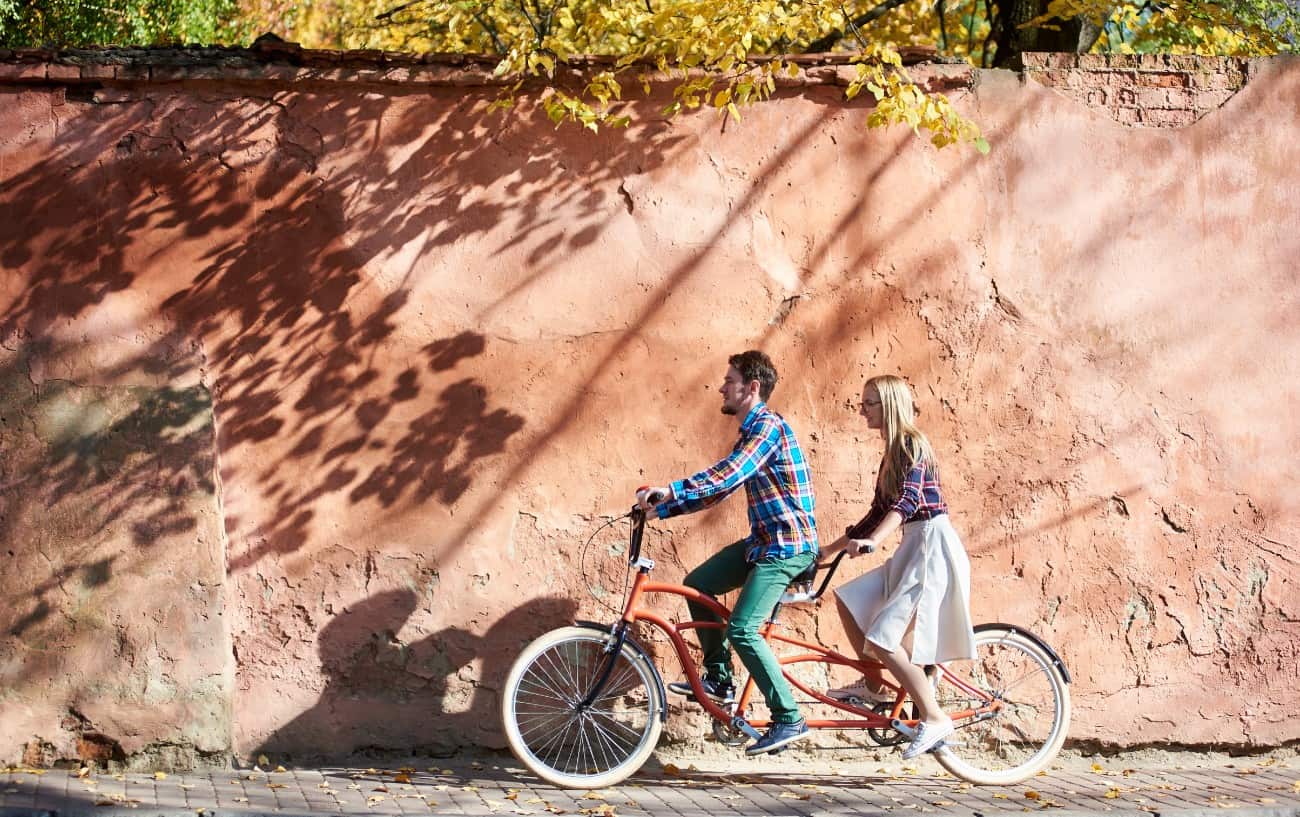
The 6 Different Types Of Tandem Bikes
#1. Touring Tandem Bike
A touring tandem bike is the most flexible of all tandem bikes. These are built for long-distance riding, which is reflected in their geometry and comfort level.
Touring tandem bikes usually have provisions for mounting panniers, bags, and racks. These features make them great for weekend adventures, as you can carry camping equipment for overnight stays.
They often come with wider tires and strong wheels. These give you more traction and allow you to ride on unpaved roads.
#2. Road Tandem Bike
Road tandem bikes are built for speed. They use components and frame materials used on regular road bikes, and their geometry puts you in an aggressive riding position.
Their short wheelbase makes them responsive in corners but less stable than bikes with longer wheelbases.
#3. Tandem Mountain Bike
Tandem mountain bikes have long wheelbases and chunky tires. This makes them more stable and gives you lots of traction when riding off-road.
Riding a mountain bike trail on a tandem requires lots of trust and courage. It’s best to find a tandem mountain bike with front and rear suspension for more comfort, traction, and confidence.
#4. Tandem Recumbent Bike
On a recumbent bike, the rider is sat down on a chair in a reclined position, with the pedals in front of them.
The altered riding position offers a very different style of riding. Some love it, some hate it – the only way to know for yourself is to give it a go!
Check out our Guide to Recumbent Bikes here.
#5. Folding City Tandem Bike
It can be tricky to store a tandem bike due to its length. Therefore, a folding tandem bike may be a good choice if space is tight. You may be able to find other types of folding tandems, but the city or hybrids are more common.
#6. Electric Tandem Bike
There is an electric bike for everyone these days, including electric tandems. The benefit of electric tandem bikes is that you get assistance from the electric motor and your partner.
Electric tandems are heavy bikes. This won’t cause you too much trouble while riding, but lifting it will be tricky. Luckily, there are two of you!
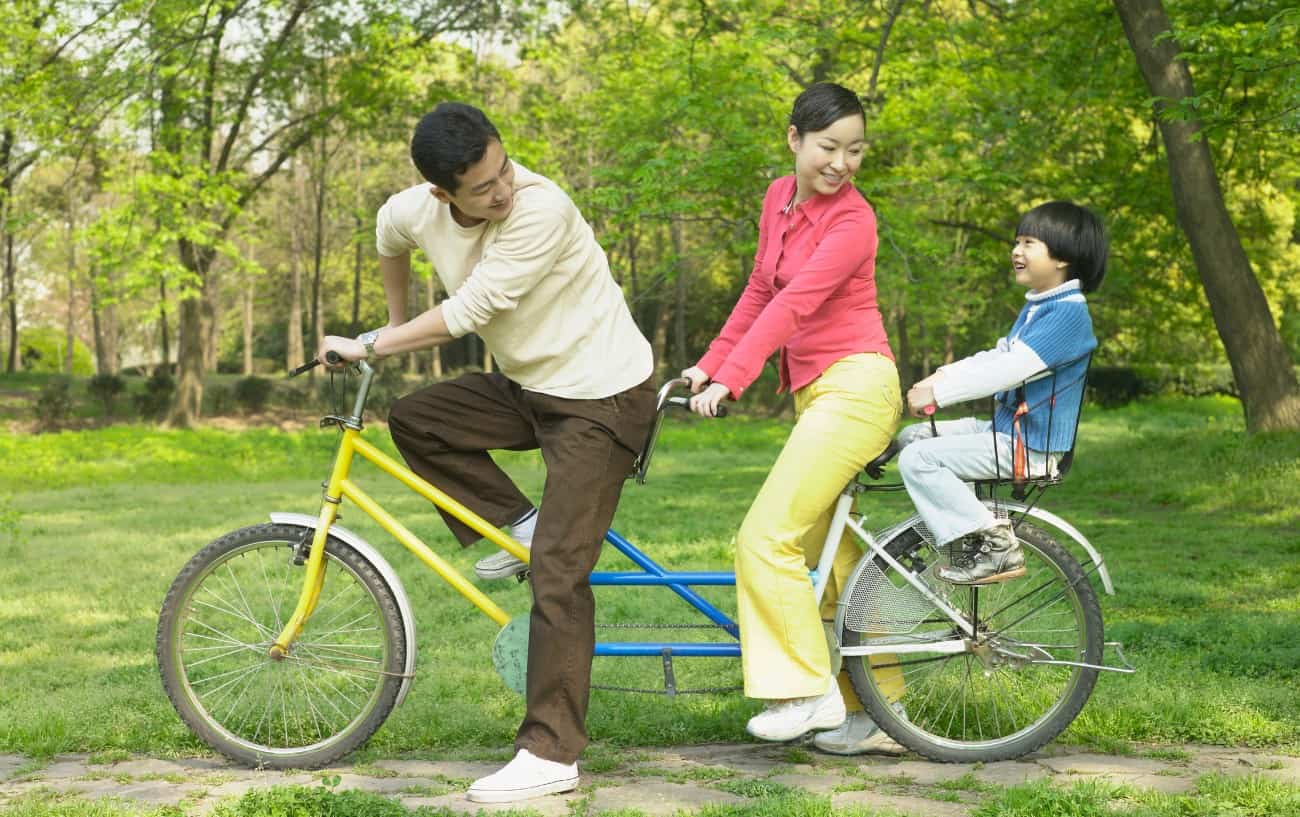
7 Things To Consider Before Buying A Tandem
#1. Make Sure You Both Have Time To Ride Together
Enthusiastic couples often buy tandem bikes without much thought. They often realize that their schedules don’t quite match for riding together, so many tandems gather dust or come up for sale pretty quickly.
So make sure that you carefully think about when you’re planning to ride together and see how realistic it is. If you only get to ride together from time to time, you may be better off buying individual bikes.
#2. Frame Design
The extra length of a tandem bike and the weight of two riders require the bike’s frame to be stiff. If you experience any lateral flex in the frame, it isn’t stiff enough and will create a scary ride.
Frame stiffness comes from how the frame is constructed and its material. Look for bikes with a diagonal tube that increases the bike’s stiffness.
More modern and higher-priced tandem bikes don’t have the diagonal tube. Instead, they use high-tech tube shaping, materials, and geometry. Which type you choose will depend on your budget.
#3. Frame Sizing
If the captain and the stoker’s heights are significantly different, you may have issues with bike sizing.
This is more the case if the stoker is taller than the captain, as they may struggle with the handlebar height. You can tweak the riding position on most tandem bikes, but it is best to ensure you get the correct frame size.
#4. Wheels
Make sure the wheels of your new tandem bike are from a reputable brand. Wheels on a tandem bike need to be incredibly strong, especially if you are going to carry camping gear for two.
#5. Brakes
Tandem bikes can pick up a lot of speed thanks to the extra pedal power. But the higher weight makes them faster than regular bikes on downhill sections.
If your tandem has rim brakes, you’ll need to be careful on the descents. Disc brakes are the best choice for staying in control and safe.
Hydraulic disc brakes offer more stopping power and control than mechanical disc brakes. Still, most tandem pairs will be OK with mechanical brakes.
#6. Gearing
The nature of riding a tandem bike means that you’ll want both higher and lower gears than you would on a regular bike. This is because you will be going faster on the flats and on descents but slower on the climbs.
Most tandem bikes have a triple chainring, so you can get enough range to cope with anything you may encounter. Some modern tandem bikes use double or single chainrings with wide mountain bike cassettes to provide a more straightforward setup.
#7. Tandem Bike-Specific Features
When it comes to buying a tandem bike, there are a few extra features that you wouldn’t normally consider when buying a regular bike.
One of the features is the stoker’s seat post. The stoker doesn’t usually get a good forward view, so they cannot prepare themselves for rough surfaces, speed bumps, and potholes by standing up on the pedals. Therefore, you may want to consider a suspension seat post for the stoker.
Some tandem bikes come with a third brake. This is used to assist the main brakes when you’re moving. But it’s more beneficial as a parking brake. As with the other controls, the third brake is best operated by the captain. This is because the captain has a better idea of what is going on ahead of the bike.
The tandem needs to connect the rider’s pedaling. Most tandem bikes do this using a crossover drive. This consists of a single chainring on the left connected by a timing chain.
A crossover drive is more expensive than using two standard chainsets due to the limited numbers used. You may come across older tandems with the timing chain on the right-hand side connected to the inner gear of a triple chainring. This means the bike uses two conventional chainsets, but the outer chainrings are used for the final drive.
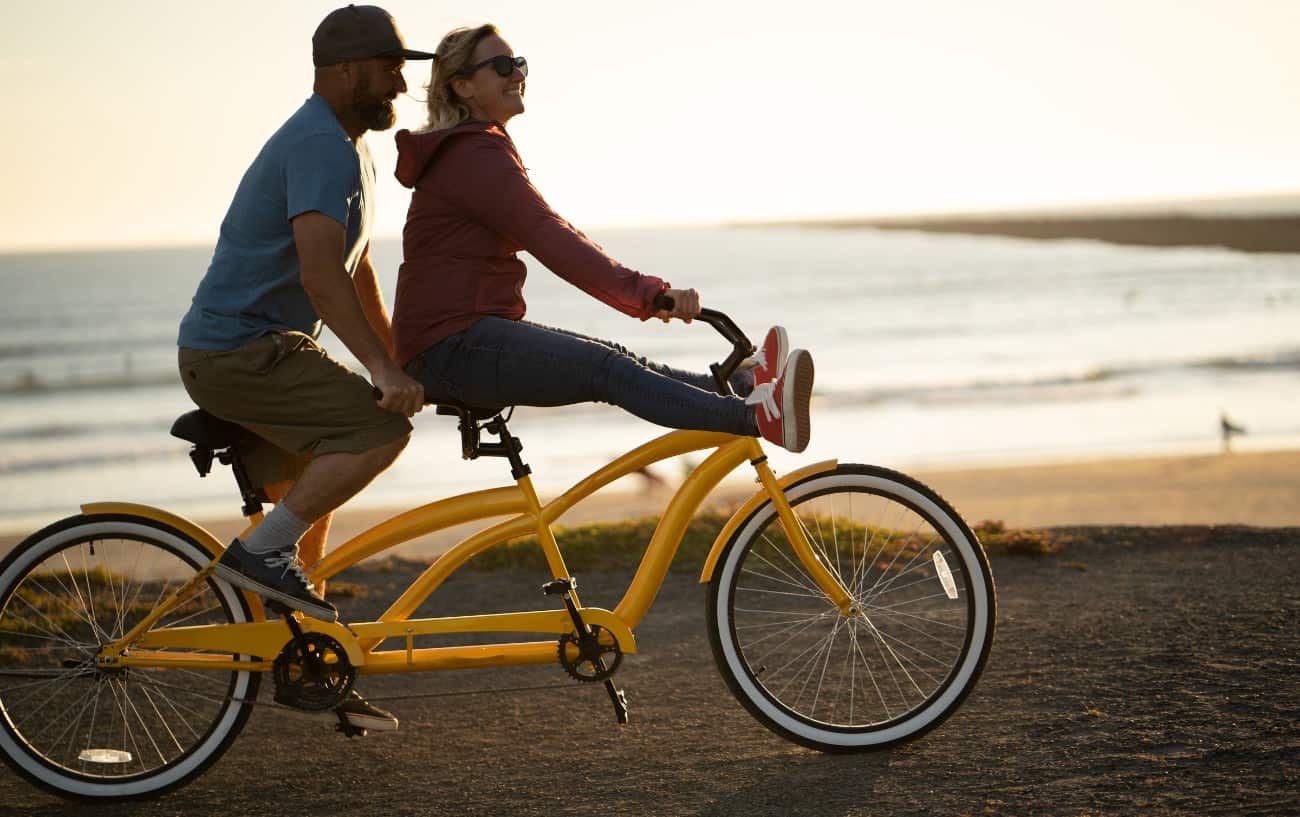
Now You Know About All The Types Of Tandem Bikes…
It’s best to start with thinking about the type of riding you want to do, as it will determine which type of tandem will suit you best.
Once you have decided on the type of tandem bike, you can then make sure you find one with the correct features.
If you’re interested in tandem riding – give it a go! You’ll be feeling confident riding as a pair in no time.
